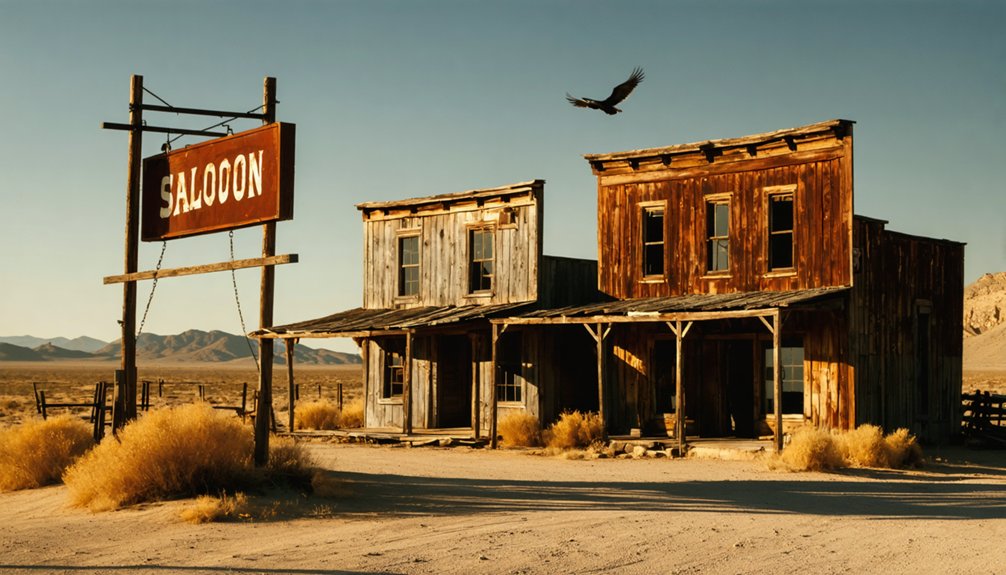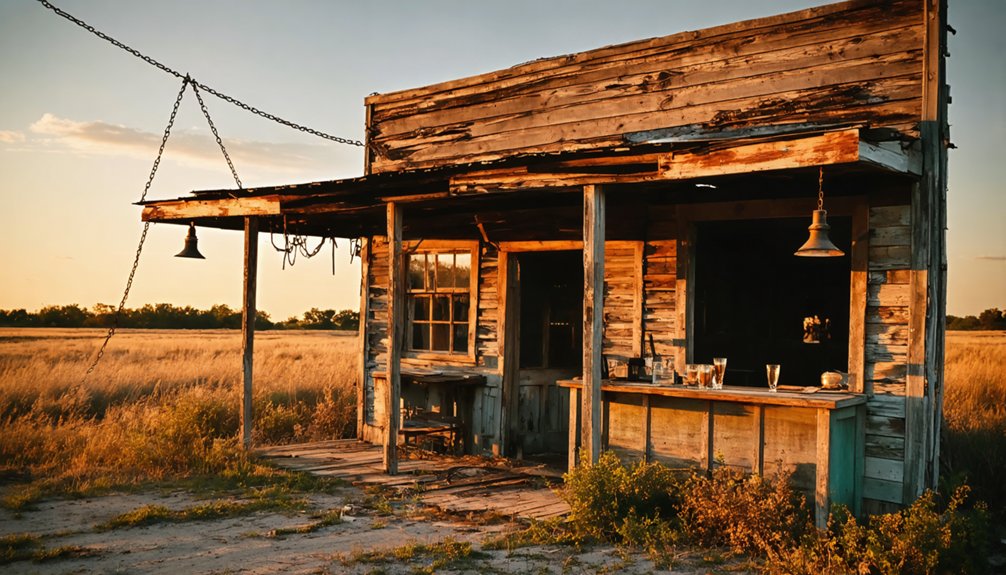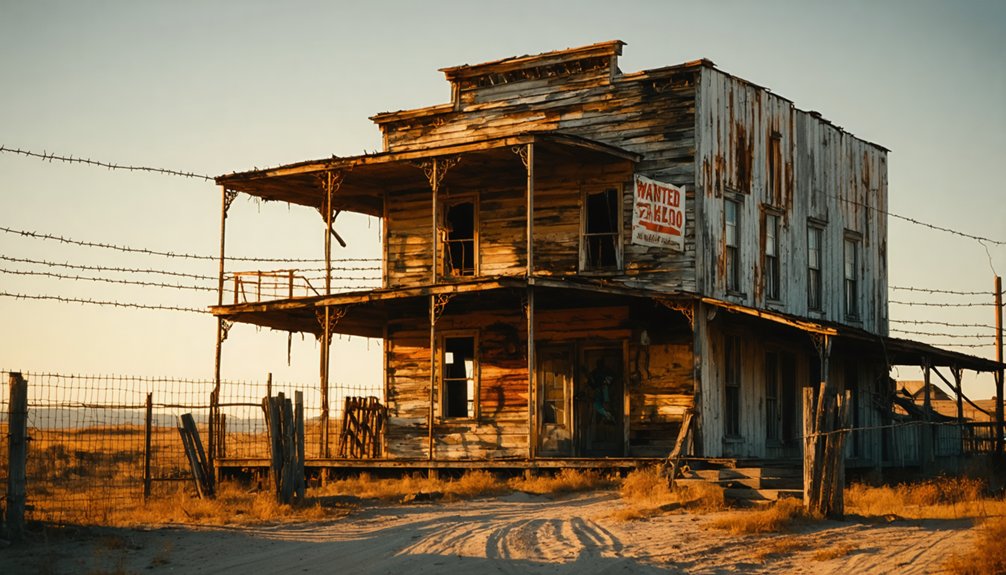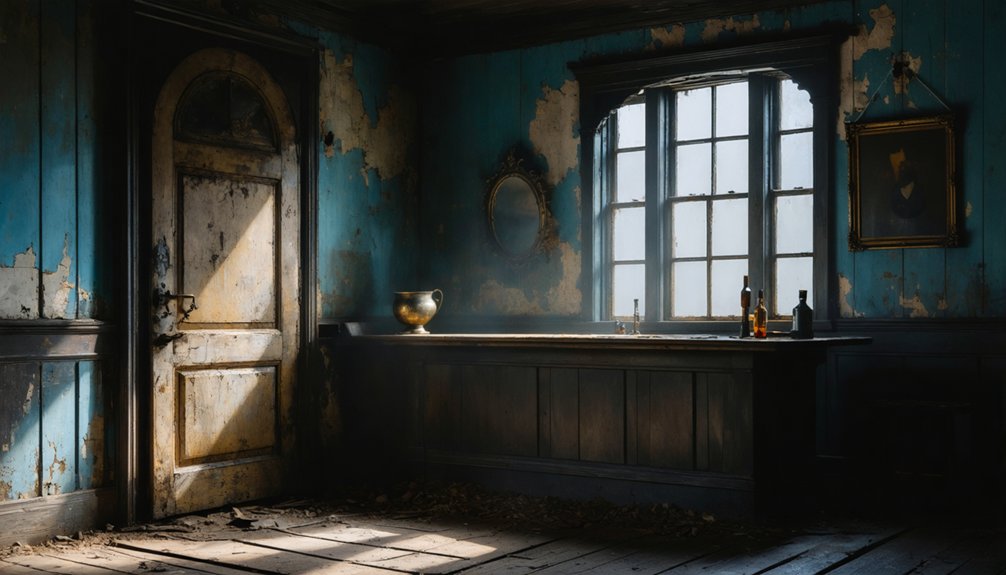You’ll find Texas’s best-preserved ghost towns in Terlingua, a former mercury mining center with authentic desert ruins; Glenrio, a Route 66 border town frozen in time with 17 abandoned structures; and Fort Griffin, an 1867 military outpost featuring partial ruins and a restored bakery. Each site offers unique glimpses into the Wild West, from mining prosperity to frontier lawlessness. These historical landmarks tell stories that transport you directly to Texas’s rugged past.
Key Takeaways
- Terlingua preserves authentic mercury mining ruins, cemetery, and repurposed historic buildings like the Starlight Theatre.
- Glenrio offers 17 well-preserved Route 66 structures on the Texas-New Mexico border, recognized as a National Register Historic District.
- Fort Griffin maintains military outpost ruins from 1867, including barracks and a restored bakery that once served frontier soldiers.
- Each town showcases different aspects of Texas frontier life: mining culture, highway commerce, and military-civilian interactions.
- All three ghost towns host cultural events or preservation efforts that maintain their historical significance and attract visitors.
Terlingua: Desert Mining Ruins With a Living Legacy
Nestled in the harsh Chihuahuan Desert, Terlingua stands as one of Texas’s most authentic ghost towns with a surprisingly vibrant present.
Once a thriving mercury mining center that produced 40% of America’s quicksilver by 1922, Terlingua history is etched in its weathered ruins and the poignant cemetery dating back to 1903.
You’ll discover remnants of the town’s divided past—separate quarters for Mexican and Anglo workers—while exploring abandoned mine shafts and the crumbling St. Agnes Church.
The Starlight Theatre and Chisos Mining Company store have been repurposed, anchoring today’s eclectic Terlingua community of artists and desert dwellers.
Despite its ghost town status, Terlingua pulses with cultural energy, hosting the famous chili cook-off since 1967 while serving as a gateway to Big Bend National Park. The town celebrates its cultural heritage with the annual Dia De Los Muertos celebration where locals honor ancestors at the historic cemetery. Howard Perry’s mansion, constructed in 1906 and expanded in 1911, stands as a testament to the mining prosperity that once defined this remote desert community.
Glenrio: A Frozen-in-Time Route 66 Border Town
Straddling the Texas-New Mexico border like a forgotten sentinel, Glenrio offers Route 66 enthusiasts a genuine frozen-in-time experience that few ghost towns can match. Established in 1901 alongside the railroad and renamed in 1908, this prairie outpost thrived during America’s highway heyday despite never housing more than a few dozen residents.
When Interstate 40 diverted traffic in 1973, Glenrio’s pulse faded.
Today, you’ll find a National Register Historic District containing 17 abandoned structures—silent testimonies to mid-century American travel. The name itself blends Scottish and Spanish words, representing the cultural crossroads this borderland represents. The Little Juarez Cafe, vintage gas stations, and old motel ruins stand as monuments to historic preservation efforts along the Mother Road. What’s particularly fascinating is the town’s unique division that once meant visitors could only purchase alcohol on the New Mexico side of the state line.
Step back in time as abandoned cafes and forgotten motels whisper stories of America’s highway golden age.
You’re walking through living history here, 73 miles west of Amarillo, where scenes from “The Grapes of Wrath” were filmed in 1940.
Fort Griffin: Where Military History Meets Frontier Legends
Deep in the heart of Shackelford County stands Fort Griffin, once the cornerstone of America’s southwestern frontier defense system. Established in 1867, this military strategy outpost protected settlers from Comanche raids while inadvertently spawning “Babylon on the Brazos” – a settlement notorious for its lawlessness culture that attracted outlaws, gamblers, and buffalo hunters.
Today, you’ll find:
- Partial ruins including barracks, administration buildings, and a restored bakery
- Archaeological remnants protected as a State Landmark and National Historic Place
- A 506-acre historic site managed by the Texas Historical Commission
When the fort closed in 1881 and railroads bypassed the area, Fort Griffin’s decline was inevitable. The town was once known by several names including The Flat before officially adopting Fort Griffin as its name. The fort’s bakery was particularly impressive, producing up to 800 bread loaves daily to feed the stationed soldiers.
Visit this ghost town to witness the delicate balance between military discipline and frontier chaos that defined America’s westward expansion.
Frequently Asked Questions
Are These Ghost Towns Safe for Families With Young Children?
You’ll find ghost towns can be safe with supervision. Keep children close during family activities, watch for structural hazards, and practice proper ghost town etiquette by never climbing on historic structures.
What Is the Best Season to Visit Texas Ghost Towns?
Autumn (September-November) offers you ideal conditions for ghost town exploration. You’ll enjoy comfortable 70-85°F temperatures, best photography opportunities with fall foliage, and numerous seasonal events like haunted tours and Halloween festivities.
Can You Camp Overnight in or Near These Towns?
You can’t camp inside ghost towns, but you’ll find designated camping nearby with proper overnight permits. Follow camping regulations at state parks and private lands surrounding these historic sites.
Are There Guided Tours Available at All Locations?
No, guided tour options aren’t available at all locations. You’ll find formal tours at popular sites like Terlingua, where experts explain ghost town history, while smaller towns require self-guided exploration.
How Accessible Are These Towns for Visitors With Mobility Issues?
Over 70% of these sites present significant challenges. You’ll find limited wheelchair access due to rugged terrain and unpaved surfaces. Parking facilities exist near main attractions, but distances to structures vary considerably across locations.
References
- https://www.homestratosphere.com/best-small-towns-in-texas-for-experiencing-old-west-culture/
- https://www.mikecoxauthor.com/p/the-history-of-every-old-west-ghost
- https://www.county.org/county-magazine-articles/summer-2025/ghost-towns
- https://www.youtube.com/watch?v=Zd8-gKw-5Hc
- https://texappealmag.com/texas-ghost-towns-explore-haunting-remnants-of-forgotten-cities/
- https://m.dresshead.com/files/scholarship/Documents/Ghost_Towns_Lost_Cities_Of_The_Old_West_Shire_Usa.pdf
- https://www.amysatticss.com/ghost-towns/
- https://www.youtube.com/watch?v=AsCuwE0joO0
- https://texashighways.com/travel-news/four-texas-ghost-towns/
- https://www.hipcamp.com/journal/camping/texas-ghost-towns/



